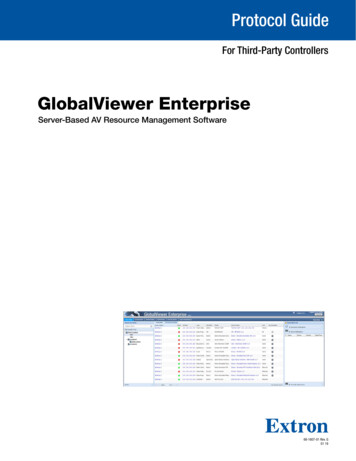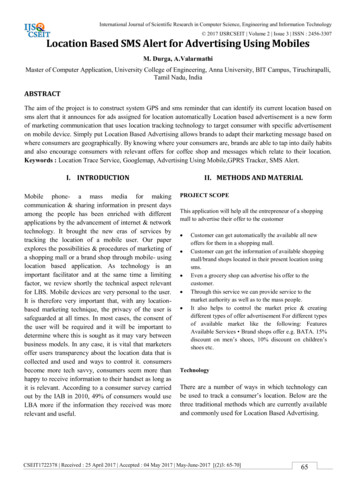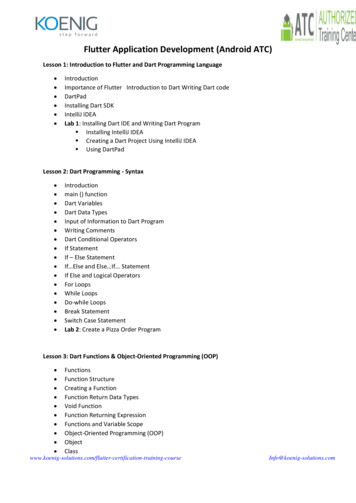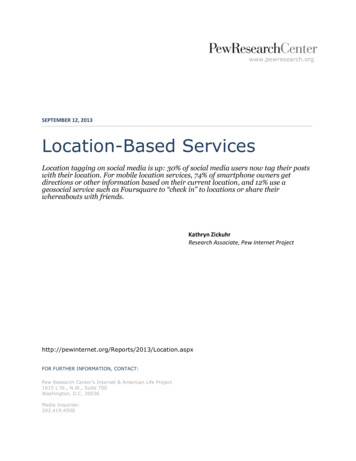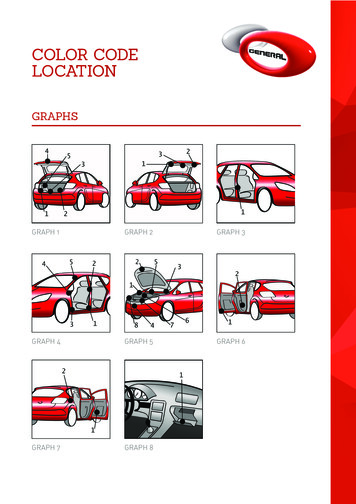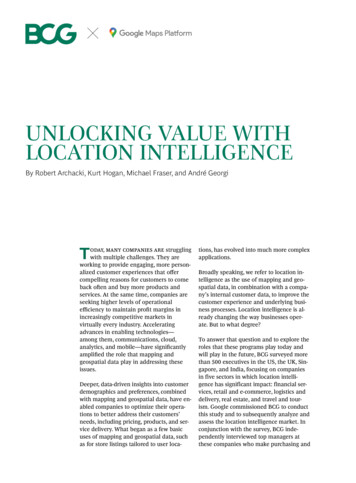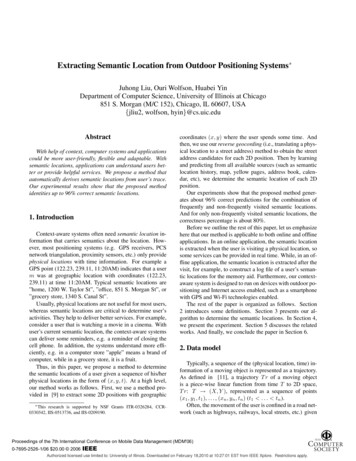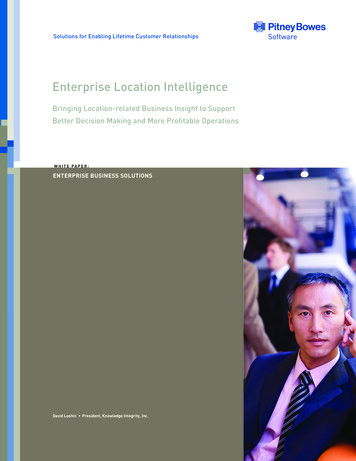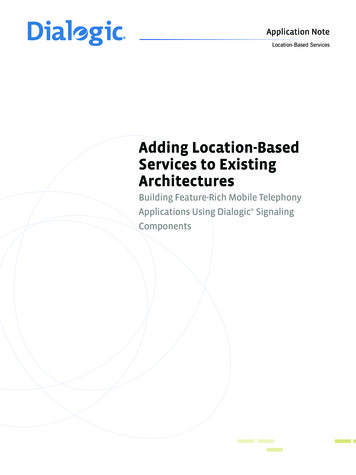
Transcription
Application NoteLocation-Based ServicesAdding Location-BasedServices to ExistingArchitecturesBuilding Feature-Rich Mobile TelephonyApplications Using Dialogic SignalingComponents
Application NoteAdding Location-Based Services to Existing ArchitecturesExecutive SummaryThis application note provides an overall view of Location-BasedServices (LBS), describes the signaling and technology involved, anddiscusses how Dialogic signaling components can be used inimplementing such services.Beginning with an overview of the LBS network architecture, thisapplication note discusses positioning mechanisms used by Global Systemfor Mobile Communications (GSM) LBS service providers, and providestwo examples of signaling flows for LBS service scenarios.System designs are also considered, showing how high performanceLBS application platforms can be developed with Dialogic SignalingDistributed Architecture (SigDiA) building blocks, enabling systemdesigners to offer location-based services worldwide.
Adding Location-Based Services to Existing ArchitecturesApplication NoteTable of ContentsIntroduction. 2LBS Network Architecture. 2Positioning Mechanisms . 3Uplink Time of Arrival (TOA) . 3Enhanced Observed Time Difference (E-OTD). 4Global Positioning System (GPS) Assisted. 4Creating LBS Applications. 5LBS “Push” and “Pull” Service Models. 5Information for System Design: Working with MAP Signaling . 8Dialogic Building Blocks for LBS . 9Summary. 10References . 10Acronyms . 11For More Information. 111
Application NoteAdding Location-Based Services to Existing ArchitecturesIntroductionLBS Network ArchitectureLocation-Based Services (LBSs) provide the ability todeliver high-value content to an end user, based onknowledge of the end-user’s location.Adding an LBS to an existing GSM network requiresadding several LBS network elements. These elements,shown in green in Figure 1, enable the network todetermine the location of a particular mobile handset[3GPP TS 03.71].Applications include: Information services — Events, traffic, locationrelevant services normally initiated by a mobilehandset user Location Services Client — The LBS serviceapplication that either initiates LBS queries orresponds to LBS queries from a mobile handset. Tracking — Fleet management, asset tracking, andpeople tracking Gateway Mobile Location Center (GMLC) —The connection to the mobile network for the client’sLBS service application. The GMLC sends requestsfor mobile handset location information to a MobileSwitching Center (MSC) and receives the results ofsuch requests. The GMLC can also request routinginformation from the Home Location Register (HLR).(Mobile Application Part [MAP] connections to theGMLC are via “Lh” and “Lg” interfaces as describedin [3GPP TS 03.71].) Advertising and marketing — Location-based adsand location-sensitive pages normally sent to amobile handset userFor high-value content to be delivered to an end user, anLBS must know the location of the mobile handset. Thefollowing sections discuss GSM network elements designedto support LBS services, as well as positioning mechanismsthat can be used by mobile networks.SMLCLMUMSC/VLRVisitor LocationRegister (VLR)MSC/VLRRadioBase StationSubsystem(BSS)MobileSwitchingCenter (MSC)LocationServicesClientFigure 1. Adding LBS to the GSM Network2Home LocationRegister (HLR)GMLC
Adding Location-Based Services to Existing Architectures Location Measurement Unit (LMU) — Connects with the Base StationSubsystem (BSS) of the GSM network and takes radio measurements tosupport a location-based service. Serving Mobile Location Center (SMLC) — Controls a series of LMUs inorder to receive radio interface timing measurement information. From thisinformation, the SMLC can determine a mobile handset’s position, plus givean indication of the accuracy of positioning information.Note: The SMLC and GMLC functions could be parts of a single network element.Positioning MechanismsThere are a number of positioning mechanisms that could be used by mobileoperators seeking to provide an LBS service. The 3rd Generation PartnershipProject (3GPP) currently proposes a number of methods [3GPP TS 03.71]. Uplink Time of Arrival (TOA) Enhanced Observed Time Difference (E-OTD) Global Positioning System (GPS) AssistedUplink Time of Arrival (TOA)This positioning method utilizes the fact that radio waves travel at the speed of light;therefore, the propagation delay for a signal to travel a known distance is constant.The uplink TOA mechanism requires three or more network Location MeasurementUnits (LMUs) (see Figure 1) to measure the arrival time of a signal sent from amobile handset (see Figure 2). The difference in arrival time of the mobile signal atdifferent network LMUs is used by the network’s Serving Mobile Location Center(SMLC) to determine the handset’s location.A benefit of the uplink TOA positioning mechanism is that it can be used withexisting GSM handsets [3GPP TS 03.71].Application NoteCell IDAvailable in GSM networks isthe “Cell ID” parameter. Thisvalue is present in the mobilehandset’s Subscriber IdentityModule (SIM) card and theGSM network itself. The Cell IDvalue can be converted to alocation estimate using detailsof mobile network cell coveragepresent in the SMLC.The Cell ID value alone may notnecessarily be an accurate wayto determine the location of aparticular mobile handset. Inurban environments, theaccuracy is typically around1.24 mi. (2 km), although thiscan improve in city centers toaround .3 mi. (500 m).Accuracy can be 3.1 mi.(5 km or worse) in suburbanand rural environments whichhave fewer base stations [Raja].To determine the Cell ID amobile handset is currentlylocated within, the SS7 “MAPAny Time Interrogation” servicecan be used, as described in[3GPP TS 09.02].Source: K. Raja, W.J. Buchanan, and J. Munoz;“We Know Where You Are”, IEE Communications Engineer, June 2004Figure 2. Uplink Time of Arrival (TOA)3
Application NoteAdding Location-Based Services to Existing ArchitecturesEnhanced Observed Time Difference (E-OTD)This positioning mechanism requires a handset to measure the arrival time of signals sent from three or more base stations. In “assisted” mode, the handset reports this information back to the SMLC. The SMLC uses these radio timingmeasurements to determine the handset location, as shown in Figure 3. In “handset-based” mode, the mobile handset itself makes use of timing measurement information to deduce thecurrent location.E-OTD requires modification to a standard GSM handset in order for radio timing measurements to be carried out, and for themobile handset (in “handset-based” mode) to estimate the current location. Accuracy is typically 164 yds ( 150 m) [Raja].Source: K. Raja, W.J. Buchanan, and J. Munoz;“We Know Where You Are”, IEE Communications Engineer, June 2004Figure 3. Enhanced Observed Time Difference (E-OTD)Global Positioning System (GPS) AssistedThis positioning mechanism is similar to the E-OTD technique just discussed, in that timing measurements are carried outbased on signals received in order to determine mobile handset location. For “GPS assisted” positioning, these signalswould come from a GPS satellite network, instead of GSM base station equipment, as shown in Figure 4.“Assistance data” can be sent to a mobile handset from the GSM network as location information is required. Assistancedata can take the form of a list of visible GPS satellites, from which a handset takes measurement information that aidslocation determination.“GPS assisted” positioning requires a mobile handset that can receive signals from GPS satellites. Accuracy is typically 109yds ( 100 m) [Raja].4
Adding Location-Based Services to Existing ArchitecturesApplication NoteGPSAssistedPositioningMechanismSource: K. Raja, W.J. Buchanan, and J. Munoz;“We Know Where You Are”,IEE Communications Engineer, June 2004Figure 4. GPS AssistedCreating LBS ApplicationsLBS applications can be developed without knowingthe underlying positioning mechanism used within aspecific mobile network. This simplifies the developer’stask, allowing LBS applications to be deployed acrossmobile networks that support different LBS positioningmechanisms.The LBS application developer requires connection to amobile network. This can be obtained through negotiationwith a mobile network provider and could be either anSS7 MTP-based connection or a SIGTRAN IP-basedconnection. When negotiating with a mobile networkprovider, the developer can ensure the mobile networksupports a positioning mechanism as follows: Mobile handsets used by potential end customersof the LBS service can be supported. For example,the Uplink TOA positioning mechanism supportsexisting GSM handsets. Positioning information provided by the mobilenetwork meets the accuracy requirements of theapplication.LBS “Push” and “Pull” Service ModelsLBS applications provide data based on the location ofthe mobile subscriber and can be segmented into “push”and “pull” models. The “Push” model is one in which information isproactively sent to subscribers. “Opt-in” mobileadvertising is emerging as an effective way to senddiscounts, promotions, and contests to consumerswho give their permission to receive such alerts. “Pull” services are used by subscribers to retrieve areainformation. Examples of this type of LBS beingdeployed include:— Driving Directions — Obtain directions fromyour location to your desired destination— Maps — View maps on your phone, detailingyour current location— City Guides — Find local ATMs, restaurants,stores, and attractionsExample 1: Local Promotion Implementation (“Push”)Sending an advertisement for a local service/restaurant/promotion directly to a mobile subscriber’s phone isone example of a “push” LBS. This application sendsinformation to a mobile subscriber’s handset advertisinga specific service based on the mobile subscriber’scurrent location. Figure 5 shows this graphically.5
Application NoteAdding Location-Based Services to Existing ArchitecturesUser Application Platform‘Local Promotion’ApplicationGMLCHLRVisited MSCSMLCBSC1. LBS-Request From Application2. MAP Send Routing Info for LCS3. MAP Send Routing Info for LCS (ack)4. MAP Provide Subscriber Location5. BSSMAP-LE —Perform Location RequestSignaling between VMSC, SMLC, LMU, BSC,and mobile handset within the GSM networkas detailed in [3GPP TS 03.71] section 7.6.1‘Mobile Terminating Location Request (MT-LR)’6. BSSMAP-LE —Perform Location Response7. MAP Provide Subscriber Location (ack)8. LBS—Response to Application9. Promotional information sent to mobile handset as a text or multimedia messageSource: European Telecommunications Standards Institute (ETSI)Figure 5. Request the Location of a Particular Mobile HandsetThe application can request the location of a particularmobile handset, as shown in Figure 5. Signaling is usedby this “push” application as follows:1. The “local promotion” application sends a request tothe GMLC to locate a particular mobile handset.2. The application developer’s “GMLC node” queries theHLR to determine the MSC currently visited by thespecified mobile handset. The MAP message, SendRouting Info for LCS, is used to request thisinformation. A specific handset is identified by eitherthe Mobile Subscriber ISDN number (MSISDN) orInternational Mobile Subscriber Identify (IMSI)number of the handset.3. The visited MSC address is returned to the GMLCnode using MAP Send Routing Info for LCS (ack).4. The GMLC node requests the location of the specificmobile handset from the visited MSC using the MAPmessage Provide Subscriber Location.65. Authentication and location determination are performedwithin the mobile network to determine the position ofthe specific mobile set, using one of the positioningmechanisms described in this application note.6. Once the location has been determined, a PerformLocation Response message is returned from SMLC tothe VMSC.7. VMSC returns the location information to theapplication developer’s GMLC node in the MAPmessage Provide Subscriber Location (ack) (see theshaded area). The received Provide Subscriber Location(ack) information includes details on the “locationestimate” for the specific handset and the “age of thelocation estimate” information.8. Location information will be passed to the “LocalPromotion” application itself.9. Once the “Local Promotion” application has details ofthe subscriber’s “location estimate”, the applicationcould send a text or multimedia message to thesubscriber’s handset, advertising local services of interest.
Adding Location-Based Services to Existing ArchitecturesApplication NoteUser Application Platform‘City Guide’ApplicationGMLCHLRVisited MSCSMLCBSC1. Mobile subscriber calls or sends a text message to ‘City Guide’ applicationplatform requesting location—based information2. LBS—Request From Application3. MAP Send Routing Info for LCS4. MAP Send Routing Info for LCS (ack)5. MAP Provide Subscriber Location6. BSSMAP-LE—Perform Location RequestSignaling between VMSC, SMLC, LMU, BSC,and mobile handset within the GSM networkas detailed in [3GPP TS 0.371] section 7.6.1‘Mobile Terminating Location Request (MT-LR)’7. BSSMAP-LE—Perform Location Response8. MAP Provide Subscriber Location (ack)9. LBS—Response to Application10. City Guide Application sends desired LBS information to mobile handsetvia text or multimedia messageSource: European Telecommunications Standards Institute (ETSI)Figure 6: Mobile User Requests LBS “City Guide” InformationExample 2: City Guide Implementation (“Pull”)Here, the mobile user requests information aboutthe local area. Information is provided to themobile users based on their current location(see Figure 6). The application developer can use aplatform similar to that discussed in Example 1.Signaling is used by this “pull” application asfollows:1. The mobile user requests information about thelocal area (possibly looking for a restaurant or ahotel) in one of two ways: Calling the “City Guide” application platformand interacting with it via an Interactive VoiceResponse (IVR) system Sending a text message requesting specificinformationWhat location information does the ProvideSubscriber Location (ack) message provide tothe application developer?As described in Examples 1 and 2, the user’s LBS application willbe sent information detailing the “location estimate” of a particularmobile subscriber. The information received will include“geographical information,” as described in [3GPP TS 09.02].“Geographical information” gives the location of a subscriber as ashape, such as an “ellipsoid point,” which can be used to detail apoint on the Earth’s surface in terms of latitude and longitude.As described in [3GPP TS 09.02], one of several different shapescould be returned in the Provide Subscriber Location (ack)message “location estimate” information.Details of shape definitions and descriptions (including shapeencoding within MAP messages) are given in [3GPP TS 23.032].The “age of location estimate” information is provided in terms ofan integer, giving the number of minutes since the mobile handsetwas last contacted, as described in [3GPP TS 09.02].7
Application Note2. The “City Guide” application sends a request to theGMLC implementation to locate a particular mobilehandset.3. The application developer’s “GMLC node” queriesthe HLR to determine the MSC currently visited bythe specified mobile handset. The MAP messageSend Routing Info for LCS is used to request thisinformation. A specific handset is identified by eitherthe MSISDN or IMSI number of the handset.4. The visited MSC address is returned to the GMLCnode using MAP Send Routing Info for LCS (ack).5. The GMLC node requests the location of the specificmobile handset from the visited MSC using the MAPmessage Provide Subscriber Location.Adding Location-Based Services to Existing ArchitecturesInformation for System Design: Workingwith MAP SignalingAn implementation of the City Guide applicationplatform just described is capable of carrying out thefollowing steps: Receive Short Message Service (SMS) messages frommobile users requesting LBS information. Send MAP Send Routing Info for LCS messages andreceive routing information. Send MAP Provide Subscriber Location messages(using routing information) and receive “locationestimate” and “age of location estimate” informationfor a handset. Act on the location information received, todetermine which LBS data is sent to the mobile user. Finally, send LBS data to the mobile user in an SMSmessage.6. Authentication and location determination are performedwithin the mobile network to determine the position ofthe specific mobile set, using one of the positioningmechanisms described in this application note.7. Once the location has been determined, a PerformLocation Response message is returned from SMLC tothe VMSC.8. The VMSC returns the location information to theapplication developer’s GMLC node in the MAPmessage Provide Subscriber Location (ack). The receivedProvide Subscriber Location (ack) information includesdetails on the “location estimate” for the specific handsetand the “age of the location estimate” information.9. Location information will be passed to the “CityGuide” application itself.10. Once the “City Guide” application platform has anestimate for the location of the mobile handset, specificLBS information can be supplied to the handset.8SMS and LBS services are provided by the MAP. MAPuses the services of Transaction Capabilities ApplicationPart (TCAP) and Signaling Connection Control Part(SCCP), as shown in Figure 7.The Dialogic SS7 Protocols MAP Test Utility (MTU)demonstrates how to build an application that can sendand receive MAP messages using the services of TCAPand SCCP. This could be a starting point to develop anapplication such as described in the “Example 1: LocalPromotion Implementation” or “Example 2: City GuideImplementation” [MTU and MTR User Guide].The MTU has been developed to handle SMS messages.This functionality can be used to provide LBS informationto a mobile handset as described in step 9 of the “LocalPromotion” service, or step 10 of the “City Guide”application, previously described.Further development of the MTU source code (outsidethe scope of this application note [MTU and MTR UserGuide]) would enable a developer’s application platform(acting as the GMLC-node) to send and receive MAPSend Routing Info for LCS and MAP Provide SubscriberLocation messages.
Adding Location-Based Services to Existing ArchitecturesApplication NoteLBS ApplicationMAPTCAPSCCPMTP or SIGTRANFigure 7. SS7 Protocol Layers for MAP ApplicationsDialogic Building Blocks for LBSDialogic Signaling Distributed Architecture (SigDiA) enabled building blocks can be used to create the network elementsfor developing an LBS service.As an example, Figure 8 shows dual Dialogic SS7G22 Signaling Servers operating in Signaling Interface Unit (SIU) modeand SIU hosts acting as a Location Services Client and GMLC node, to create a User Application Platform.SMLCLMUMSC/VLRVisitor LocationRegister (VLR)MSC/VLRRadioBase StationSubsystem(BSS)MobileSwitchingCenter (MSC)LocationServicesClientHome LocationRegister (HLR). . . . . . . .GMLC NodeUser Application Platform Implemented Using SS7G22 and SIU HostsFigure 8. Implementing a User Application Platform with Dialogic Signaling Building Blocks9
Application NoteFor GSM MAP signaling, a number of building blocksare available, including: Dialogic SS7AM1 SS7 Interface Board —http://www.dialogic.com/products/signalingip ss7components/Signaling Boards SS7AM1.htm Dialogic Signaling Server with Signaling GatewayOption (Dialogic SS7G21 and SS7G22 SignalingServers) —http://www.dialogic.com/products/signalingip ss7components/signaling servers and gateways.htm Dialogic SS7HDC SS7 Interface Board (cPCI) —http://www.dialogic.com/products/signalingip ss7components/Signaling Boards SS7HDC.htm References[3GPP TS 03.71] Digital Cellular TelecommunicationsSystem (Phase 2 ), Location Services (LBS), FunctionalDescription, Stage 2, ETSI TS 101 724 V8.8.0 .[3GPP TS 09.02] Digital Cellular TelecommunicationsSystem (Phase 2 ), Mobile Application Part (MAP)Specification ETSI TS 100 974 V7.15.0 .[3GPP TS 23.032] Universal Geographical AreaDescription (GAD) ETSI TS 123 032 V6.0.0 . Dialogic SS7HDP SS7 Interface Board (PCI) —http://www.dialogic.com/products/signalingip ss7components/Signaling Boards SS7HDP.htm[MTU and MTR User Guide] Dialogic SS7 Protocols MAPTest Utility (MTU) and Responder (MTR) User Guide ng/software3.htm. Dialogic SPCI4 SS7 Interface Board —http://www.dialogic.com/products/signalingip ss7components/Signaling Boards SPC.htm[Raja] K. Raja, W.J. Buchanan, J. Munoz. “We Know WhereYou Are”, IEE Communications Engineer June/July 2004;http://www.theiet.org/. Product choice depends on the level of integration, theexpected transaction traffic, and the level of fault tolerancerequired, etc. The same Application Programming Interface(API) is used across the entire family of Dialogic Signalingproducts, allowing easy migration from board-based toserver-based solutions as service needs change. Furtherinformation on the range of Signaling building blocks isavailable on the web at http://www.dialogic.comSummaryThis application note presents an overview of networkarchitecture and positioning mechanisms used by GSMLBS service providers.It discusses how SS7 messaging is used for LBS services,providing information regarding signaling flows, and“push” and “pull” LBS service scenarios. The type oflocation information that can be provided by the GSMnetwork is highlighted, including references that could beuseful for system designers.Finally, the application note looks at system designconsiderations, enabling LBS service designers to developand deploy LBS applications with Dialogic signalingproducts building blocks and protocol software.10Adding Location-Based Services to Existing Architectures
Adding Location-Based Services to Existing ArchitecturesAcronymsApplication NoteFor More Information3GPP3rd Generation Partnership ProjectAPIApplication Programming InterfaceBSSBase Station SubsystemE-OTDEnhanced Observed Time DifferenceGMLCGateway Mobile Location CenterGPS assisted Global Positioning System AssistedHLRHome Location RegisterIMSIInternational Mobile Subscriber IdentityIVRInteractive Voice ResponseLBSLocation-Based ServiceLCSLocation Services (3GPP abbreviation)LMULocation Measurement UnitMAPMobile Application PartMSCMobile Switching CenterMSISDNMobile Subscriber ISDN NumberMTRMAP Test ResponderMTUMAP Test UtilitySCCPSignaling Connection Control PartSigDiADialogic Signaling DistributedArchitectureSIMSubscriber Identity ModuleSMLCServing Mobile Location CenterSMSShort Message ServiceTCAPTransaction Capabilities Application PartTOATime Of ArrivalVMSCVisited MSCDialogic SS7 Protocols MAP Programmer’s Manual ng/software3.htmGrow Revenue and Reduce Time to Market with Dialogic Building Blocks: Location-Based Services —http://www.dialogic.com/goto/?9802Dialogic Signaling building blocks —http://www.dialogic.com/products/signalingip ss7components/signaling software.htmDialogic Signaling Products Software andDocumentation ng/Dialogic building blocks for high performancecommunications solutions —http://www.diaogic.com/productsDialogic SS7 and Sigtran Signaling technical discussionforum .asp?fid 12North America “Enhanced 911 - Wireless Services” .html11
To learn more, visit our site on the World Wide Web at http://www.dialogic.com.Dialogic Corporation9800 Cavendish Blvd., 5th floorMontreal, QuebecCANADA H4M 2V9INFORMATION IN THIS DOCUMENT IS PROVIDED IN CONNECTION WITH PRODUCTS OF DIALOGIC CORPORATION OR ITS SUBSIDIARIES (“DIALOGIC”). NOLICENSE, EXPRESS OR IMPLIED, BY ESTOPPEL OR OTHERWISE, TO ANY INTELLECTUAL PROPERTY RIGHTS IS GRANTED BY THIS DOCUMENT. EXCEPT ASPROVIDED IN A SIGNED AGREEMENT BETWEEN YOU AND DIALOGIC, DIALOGIC ASSUMES NO LIABILITY WHATSOEVER, AND DIALOGIC DISCLAIMS ANY EXPRESS OR IMPLIED WARRANTY, RELATING TO SALE AND/OR USE OF DIALOGIC PRODUCTS INCLUDING LIABILITY OR WARRANTIES RELATING TO FITNESSFOR A PARTICULAR PURPOSE, MERCHANTABILITY, OR INFRINGEMENT OF ANY INTELLECTUAL PROPERTY RIGHT OF A THIRD PARTY.Dialogic products are not intended for use in medical, life saving, life sustaining, critical control or safety systems, or in nuclear facility applications.Dialogic may make changes to specifications, product descriptions, and plans at any time, without notice.Dialogic is a registered trademark of Dialogic Corporation. Dialogic's trademarks may be used publicly only with permission from Dialogic. Such permission may onlybe granted by Dialogic’s legal department at 9800 Cavendish Blvd., 5th Floor, Montreal, Quebec, Canada H4M 2V9. Any authorized use of Dialogic's trademarks willbe subject to full respect of the trademark guidelines published by Dialogic from time to time and any use of Dialogic’s trademarks requires proper acknowledgement.The names of actual companies and products mentioned herein are the trademarks of their respective owners. Dialogic encourages all users of its products to procureall necessary intellectual property licenses required to implement their concepts or applications, which licenses may vary from country to country.3GPP TSs and TRs are the property of ARIB, ATIS, ETSI, CCSA, TTA and TTC who jointly own the copyright in them. They are subject to further modifications andare therefore provided to you “as is” for information purposes only. Further use is strictly prohibited.Copyright 2007 Dialogic CorporationAll rights reserved.10/07www.dialogic.com9862-02
Advertising and marketing— Location-based ads and location-sensitive pages normally sent to a mobile handset user For high-value content to be delivered to an end user, an LBS must know the location of the mobile handset. The following sections discuss GSM network elements designed to support LBS services, as well as positioning mechanisms
